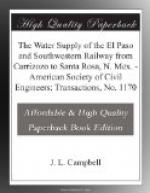This reservoir is a natural basin or bowl, 1/2 mile in diameter across the top, 1/4 mile on the bottom, and 36 ft. deep. A level line, 1,500 ft. long, drawn from its bottom, comes out to grade on the north declivity of the table-land. On this level line an open cut was made and the outlet pipe laid. The cut was then closed by a dam.
The supply pipe from Bonito Creek delivers water into the basin over the top of its southern rim, the water, as it leaves the pipe, flowing over a standard weir, without end contractions, into a stone gutter. A by-pass pipe, with suitable valves, passes around the western side of the basin and connects to the outlet pipe.
This comparatively small amount of work equipped a very good natural reservoir with a capacity of 422,000,000 gal., which can be increased to 1,000,000,000 gal. by embankments across low places in the rim.
Service Reservoirs.—At Coyote, an artificial service reservoir, 100 by 200 ft. on the bottom, with slopes of 1-1/2 on 1 and a total depth of 15 ft., serves as an equalizer of the flow to and away from the pumps at that point. The pump-house is built alongside this reservoir. The delivery pipe from the Nogal Reservoir runs directly to the pumps, but has a tee-branch, 50 ft. long, into the Coyote Reservoir. This branch passes through a valve chamber between the pump-house and the reservoir. In this chamber there are controlling valves and an automatic overflow. This overflow is provided against the contingency of a full reservoir and idle pumps. If the pipe line is delivering water faster than the pumps discharge it, the surplus goes into the reservoir. This arrangement is self-acting and controlling. There is a similar arrangement at the Luna pumping plant, also at the Carrizozo service reservoir, and at the regulating reservoir on the Corona summit.
Each of the four service reservoirs is of the same size, and lined with 4 in. of 1:2:4 concrete. At Luna and Corona the concrete is reinforced with 3/8-in. round rods spaced 12 in. from center to center, both ways. This reinforcement should have been used in all the work.
Pumping Plants.—The pumps at Coyote and Luna are Nordberg duplex, cross-compound, condensing, crank-and-fly-wheel machines, with 6-in. plungers, traveling 600 ft. per min. at full normal speed, and designed to work against 300 lb. per sq. in. They have a guaranteed efficiency of 135,000,000 ft-lb. per 1000 lb. of steam at 150 lb. and superheated 75 degrees.
The boilers are 125-h.p., Sterling, water-tube, with Foster superheaters, and 33-in. stacks, 100 ft. high.
Each plant is in complete duplicate pump and boiler units, only one set working at a time.
The pump building is a substantial concrete, brick, and steel structure, 50 by 80 ft. in plan, with a fire-wall, with two steel doors dividing the floor space into an engine-room 50 by 50 ft., and a boiler-room 50 by 30 ft. A concrete coal-bin adjoins the exterior boiler-room door. Coal is delivered directly from the car to the bin.




